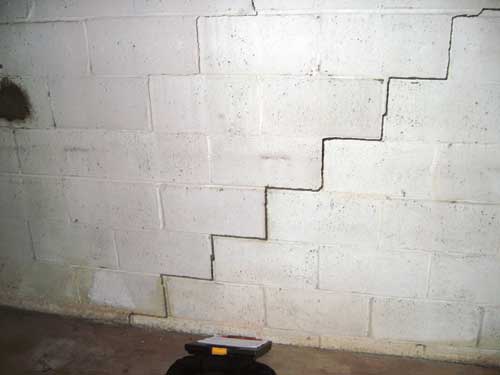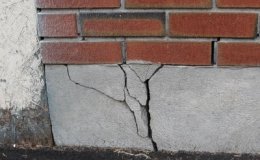 Establishing “Why” Since 1966
Establishing “Why” Since 1966
There’s no exact method for determining how serious a wall crack is, but forensic structural engineers are able to analyze the crack(s) and surrounding area to determine whether the cause of the crack is likely a surface blemish or the result of a larger problem.
Houses usually begin to settle during the first few months and are known to do so even years after construction, so minor wall cracks are likely to develop over time. It is the nature of many construction materials to crack as they age, and as they expand and contract, particularly when they are exposed to moisture then dry out.
The more commonly effected materials include concrete, asphalt, stucco, stone, brick, mortar, concrete block, plaster, and drywall which will usually only show short narrow cracks and separation. However, gaping cracks, separation and horizontal crack lines might be signs that the issues are more severe. Cracks obviously form at the weakest locations resulting from an applied stress; and case-by-case analysis of the physical characteristics of the identified cracked areas can provide insight into the origin of the stresses.
The Forensic Analysis & Engineering Corporation team of experts frequently provides site investigations and subsurface condition profiles. Our geo-technical and civil/structural engineers work together to determine or verify the specific causation of such cracks and make recommendations on how to mitigate them, and future damage.
The following are some issues to be aware of in and around homes and structures.
WHAT TO LOOK FOR:
Cracking in houses has been shown to be related to a variety of factors. Changes in humidity and temperature and occupant activities all have been shown to influence crack formation and growth (and shrinkage.) Also, clay soils and shales commonly exhibit shrink-swell behavior with changes in moisture content, leading to movement of foundations on those soils. These fine grained soils are also subject to erosion by the flow of surface or subsurface water, leading to voids under pavements or undermining of foundations.
Silty and loamy soils may also be subject to frost heave, in which water flows to the freezing front forming an ice lens that grows towards the surface. In some cases, the resulting ice lens formation can lift pavements or building foundations by several inches. Melting of the ice lens could then cause additional settlement, or leave pavement or floor slabs tilted up.
Cracking in Interior Wood-Framed Walls
A vertical crack running to or from the intersection of a wall and ceiling, and especially a diagonal crack running from the upper corner of a doorway or window opening is normally a sign of movement of the floor system. This movement may be induced by building settlement, or by deteriorated or damaged floor framing. Common causes of the latter are long term water damage, excess long-term moisture in the basement or crawlspace, settlement of structural piers or foundations, or from insect infestation.
Horizontal cracking at the intersection of the wall and ceiling may represent roof system movement, excess roof loading (such as snow loads), severe storms (tornados), or roof truss/roof framing damage. These cracks may also be seasonal cracking caused by seasonal changes in temperature and humidity.
Cracking in Masonry Walls
A stair-step crack looks like a flight of stairs and runs in both vertical and horizontal directions within the wall. The crack pattern usually follows the grout or cement lines between CMU (concrete masonry unit cinder blocks) and brick walls, although they may also crack the block or brick itself. These typically appear at or near corners, or above door and window openings in the brick and are usually an indication of building settlement. Windows may also separate from the exterior trim as a result of settlement.
Stair-step cracks in concrete or CMU basement foundation walls may also result from external pressure from saturated soils. In this case there will generally be symmetrical cracking at each end of the wall with some horizontal or vertical cracking towards the center of the wall, accompanied by inward movement of the wall, especially at the center. Courses of CMU may also separate along a horizontal grout line. Local cracking, either vertical or stair-step, may also occur from tree root invasion under the footings.
Doors and Windows
Another way to test the seriousness of a wall crack is to open and close internal doors to bedrooms and bathrooms and evaluate whether the doors stick. If so, ensure the sticking isn’t a result of paint, faulty hardware or cracked wood. If you determine there’s nothing obstructing the swinging motion of the door, it might be a sign of a moderate to severe foundation change, often resulting in wall cracks. Sticky doors could indicate that the frame has been twisted by a shifting house. If you notice a visible gap at the top of a sticky door where it meets the door frame and you see light shining through, that might also signal a serious settlement problem, often resulting in jagged, horizontal cracks on nearby walls.
Visible Nails
Study the wall area surrounding the crack and look for nail heads or screw heads that might be visible on the surface of the wall. The nail or screw might not have damaged the drywall, but it has likely pulled away from the wooden stud beneath. Nail popping might be a sign of structural problems. Nail pops are frequently associated with more serious wall cracks.
COMMON CAUSES OF CRACKING:
- Severe weather
- Moisture or freeze-thaw cycles
- Compressive forces from excess roof loading
- Structural settlement
- Tree root intrusion
- Water leakage*
- Thermal and moisture-related expansion
- Construction defects
- Soil conditions (leading to structural settlement)
- Construction equipment vibration and sound impact
- Road and rail traffic vibration
- Vehicle impact
- Fracking
Our experienced engineers are unrivaled in their extensive services that span from evaluating the stability of the soil to assessing any safety risks posed by site conditions and construction defects. FAEC also can provide full reports of geo-technical sampling and testing. Our lab results can help you make crucial decisions in construction designs and ensure a sound foundation.
To find out more or to submit an investigation request, visit our website at www.forensic-analysis.com.


Recent Comments